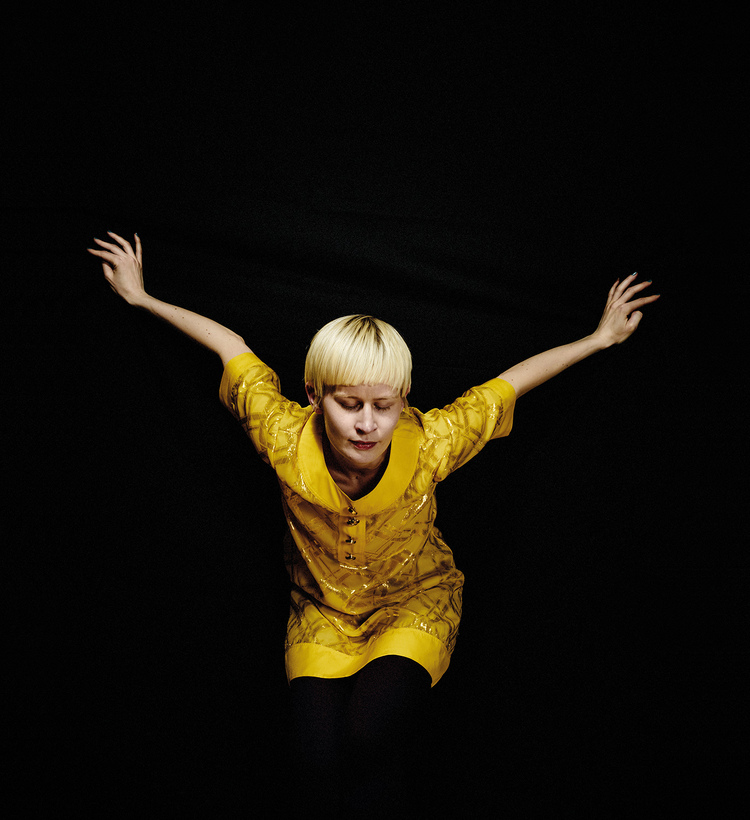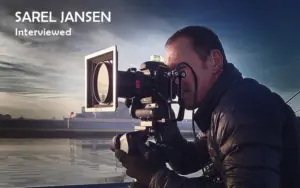The series of questions that follow were inspired by the above photograph. This photograph is a portrait of the Norwegian singer Jenny Hval that was made by Olaf Blecker, published by The New Yorker, in its June 22, 2015 Issue. It’s an odd portrait. Certain expected givens of any photograph—facts about time, place, or story—are obscured, darkened to the point of falling into a void, represented here by a surrounding blackness.
And although this void is mute (it’s a void after all), it is also roaring. It’s perhaps the first thing you noticed. If you did give it recognition, you did so automatically. And it vanished just as quickly. The blackness would have been replaced by a flash of gold in one sudden blow and expelled. Hval’s discreet smile would then mount the stage above or beneath this blackness. The void is neither background nor foreground. Fingers of shadow hug her torso, embracing her form; where her legs would be you find it again. It is also empty space.
This void can signify ignorance or chance or a gap between this world and a purer one. But is it enough to know that Jenny Hval was photographed in her apartment in Oslo? Or that Olaf Blecker was on his way to shoot another commission when he received a call from Joanna Milter from The New Yorker? Maybe this void is the force that compelled Jenny and Olaf to meet and exchange words on life influences. “I wanted to find out more from her,” Blecker told me. “We discussed more than her music and this shoot.” Maybe the void is why Olaf calls this portrait his “broken birdie” photograph. Or why he describes her wavering, almost indeterminate movement as “gliding.”
I spoke to Blecker over email about his portrait of Jenny Hval.
Before we get to the photo, I’d like to imagine its backstory, the events that led up to it being made. Let’s start with the most ordinary details. Where were you when it was assigned? Which city? Who gave you the news? Do you remember anything else about that day? Was it cloudy? Were you sick? Happy? Alone?
Actually, I had just landed in Paris for a different assignment for WIRED UK with my assistant when I called Joanna Milter from The New Yorker. She had emailed me about a portrait in Oslo, and this was the first time we got to chat about it. I remember that the rolling bag that was holding the light equipment got caught in the baggage conveyor belt system, and the workers had to shut the whole thing down. It gave me extra time to talk with Joanna about the shoot!
When do you start planning a portrait? Is it soon? Or do you wait? What were your very first steps in planning this portrait?
Joanna and I had worked together before when she was at The New York Times Magazine, so she already knew my work. For this assignment, she asked for a simple portrait of Jenny. She recommended some colorful clothing but a relatively straightforward portrait against a black background. There were, of course, logistical planning details that we needed to work out because this was on a tight schedule, and we were very lucky to work with Thea Traff to coordinate everything.
Is there anything you consider odd about your preparation? Do you have any superstitions about your process leading up to the photograph?
I would not say that I have specific superstitions, but I am sensitive to the overall “flow” that events have. For example, when we got this assignment, we were already on the road with the gear we needed, and our schedules were free for precisely the time of the shoot. When all the elements come together, especially when coming from an old friend that I have worked with before, I can be very calm and optimistic that everything will play out in a positive way.
As soon as you knew Jenny Hval was musician, did you listen to any of her music? If so, do you like it? How would you describe her music?
In this case, yes. I do not always like to know too much about my subjects because I feel it may interfere with how we work later on. I usually want to get to know the person at the moment we meet as opposed to walking in with a preconceived notion of them or their work. So there we were in Paris and after we were all set up for our job we had a few extra minutes to watch a music video of Jenny’s. The music felt quite emotional, as I remember it, and I noticed that she had a nice way of presenting herself for the camera. There was a grace to her movement.
I wanted to talk about this portrait because there’s something rare about it. A feeling of poetry emanates from it. I can’t explain its source. But the photo clicks like the last line of a poem. It conveys something beyond its factual elements: communicates more than color, light, and shadow. Am I crazy? Or do you also sense something poetic about it?
It is interesting you mention poetry, because I agree that this image has some kind of special spirit. In a similar way that a poem can sometimes speak deeper with less words than a novel, I feel that this image leaves you intrigued. It makes you want to know more.
What did you say to Hval when you met her? Did you ask her anything about her life? Did you try to talk to her about anything other than the task at hand?
When I met Jenny I wanted to find out more from her about her artistic practice. So, while my assistant was setting up, we spoke very openly about life influences, creativity, and process. I think the discussion was wide-ranging. We discussed more than her music and this shoot. This was a great assignment for many reasons but also because we had the luxury of shooting in a very intimate setting: Jenny’s apartment in Oslo.
What I love about this photo is that it seems irreducible. It’s a study of a gesture. You’ve arrived at the perfect moment. I can imagine all the other frames made right before and right after. Some with her eyes open, some slightly out of focus. I imagine you circling this one with a red pen on a contact sheet. It would be an automatic recognition that this one was special. And I’m interested in figuring out what makes it an automatic recognition, even if this recognition didn’t happen. I’m sure you’ve felt immediate answers to questions, immediate responses that didn’t wait. When something clicks instantly, what is being recognized? How do certain photos bring about a slight nod that says, “Yes, this exists in the world”?
The editing process for me is very instinctual. I look for pictures that impact me. Unfortunately, there is no clear cut answer to what this means. That is the magic of it. When I work on jobs like these, there is space for that magic to happen. So, as I was l narrowing down the selections, I simply knew that I had to keep this image in the edit even though it did not exactly fit the brief as Joanna had described: a simple, strong, head-and-shoulders portrait. Even just after we finished the shoot, I started calling it the “broken birdie” picture. This image had something else within it, and I am very happy that Joanna and The New Yorker chose to run it.
Does anything surprise you about the photo? Is it radically different from how you first conceived it?
Well, I think this photo surprised all of us. We never set out to make this photo. It happened quite organically after we had finished several other versions of head-and-shoulders portraits.
Is she about to jump up or swing down?
I would say she is gliding.
Save











